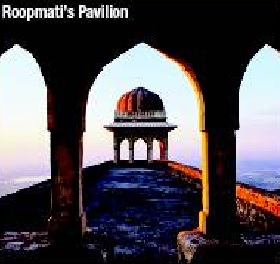Mandu, Madhya Pradesh
This is a collection of articles archived for the excellence of their content. |
Places to visit
The Times of India, Aug 26, 2011
Mandu is known as a monsoon getaway. Minarets and citadels shrouded in dark clouds whisper the romance between an emperor and a commoner. That’s not all. If shopping interests you, check out the textiles. Get your umbrella and head out to a city that is at its greenest at this time of the year! —UTTARA GANGOPADHYAY
• As the rains fill up the many lakes, the 120-metre-long, elegant Jahaz Mahal appears moored between two artificial lakes — Munj Talao and Kapur Talao. The two-storied palace housed the Sultan’s harem, comprising 15,000 beautiful women from India, Turkey and Abyssinia
• When rain clouds disappear on the odd night, the view of Hindola Mahal from the adjoining Taveli Mahal is spectacular
• Famous for the tiny domes of Hindola Mahal gracefully perched on its terrace.
• Famous for the reflection of the Jahaz Mahal in the adjoining lakes, especially at night
• The Champa Baoli, located to the west of Hindola Mahal, is an elaborately constructed well with ventilation shafts, pipes and tanks which collects rain water in its subterranean vaults and cools the palace during the arid summer months
• In monsoon, the surrounding rock faces turn lush green and the old structures, washed by rain water, don a glossy patina.
BEST TIME:
The best period to visit Mandu is Aug-Sept. While other towns in MP and most of the north and peninsular India are closed for tourism during monsoon, Mandu is more of a monsoon resort. The natural surroundings are at their prettiest during this time
GETTING THERE:
The most convenient gateways are Indore (95 km) and Ratlam (124 km). There are regular bus services from Dhar, Mhow, Ratlam, Ujjain and Bhopal. Travel within the city in autos or tempos that are available at bus-stands. Be prepared to haggle hard. Most monuments are located within a 21-sq-km radius
WHERE TO STAY:
Tourist cottages run by MP State Tourism Development Corporation are the best options — Malwa Resort (double beds starting from Rs 1,390) and Malwa Retreat (double beds starting from Rs 890)
WHAT TO EAT:
Poha is available in many varieties — peanut poha; coconut poha; aloo poha, and so on. If Indore is part of your itinerary, make sure you visit Chhappan Dukan market, which, as the name suggests, has 56 shops, selling varieties of chaat
Famous for textiles
Textiles are a popular buy. Being a small town, there may not be too many shops selling them, so if shopping is big on your agenda, plan a trip to Indore as well. Chanderi and Maheshwari sarees are a must in every woman’s wardrobe for their sheer texture and look. Comparable with the finest Dacca muslins, Chanderi sarees use a silk warp with a fine cotton weft along with gold borders and jewel-like bootis. Then there are the Maheshwari sarees. Originating from Maheswar — hence the name — these sarees were introduced by Queen Ahilya Bai who preferred to live here, away from the hustle and bustle of Indore. The intricately carved stone walls of her palace and temple are the inspiration for the exquisite borders and patterns of Maheshwari sarees. The hues of the fabric are referred to as angoori (grape green), gul bakhshi (magenta), rani (deep mauve pink) and dalimbi(deep pink).
Rani Roopmati’s jauhar
The Times of India, Aug 26, 2011
Mandu would not have caught the popular imagination if it was not for the romantic tale of Sultan Baz Bahadur and Roopmati. A patron of music and a flautist of repute, Baz Bahadur loved to roam the hills around the palace. It was during one such sojourn that he met Roopmati, a young Rajput woman. Although her father was opposed to the match, Roopmati agreed to marry the Sultan and accompany him to the palace if he could assure her that she would be able to see and pray to the river Narmada every day. The Sultan built a separate palace for Roopmati, not far from his own palace. From there, she could see the river flowing below. Unfortunately, try as you might today, it is not possible to spot the river from the now-famous Roopmati’s pavilion.The Rewa Kund, a reservoir with an aqua duct, was built to provide Roopmati’s palace with water. According to local balladeers, Emperor Akbar, after hearing about Roopmati’s beauty, sent his chieftain Adam Khan to capture Mandu and bring Roopmati to the Mughal court. Although his army put up a brave resistance, Baz Bahadur disappeared — some say he fled, others say he died in battle. As the Mughul army entered Mandu, Roopmati committed jauhar.
